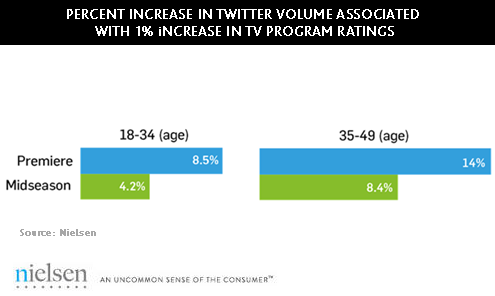Study: Correlation Between Tweets And TV Ratings
- Fahad H

- Mar 21, 2013
- 1 min read
A huge percentage of TV watchers (as much as 80 percent) are now on a “second screen” during a program, though they may not necessarily be engaged in a “social conversation” about the show they are watching. They may be shopping, writing emails or reading news, instead.
However, a new study from SocialGuide (and Nielsen) found that Twitter activity and conversations were positively correlated with TV ratings. Twitter was one of three “statistically significant variables” associated with positive TV ratings. The other two were past ratings and TV advertising (on behalf of the show).
Nielsen (and SocialGuide) found that increases in Twitter activity were related to increases in TV ratings, though they varied by age group:
Specifically, the study found that for 18-34 year olds, an 8.5% increase in Twitter volume corresponds to a 1% increase in TV ratings for premiere episodes, and a 4.2% increase in Twitter volume corresponds with a 1% increase in ratings for midseason episodes. Additionally, a 14.0% increase in Twitter volume is associated with a 1% increase in TV program ratings for 35-49 year olds, reflecting a stronger relationship between Twitter and TV for younger audiences.

One must now invoke the cautionary high-school science adage, “Correlation does not equal causation.” Popular shows are more likely to be talked about on social media. However, there may be a virtuous cycle where popular shows generate tweets, which in turn reinforce their popularity.
Awareness of a relationship between Twitter activity and TV ratings should send more networks and show producers to Twitter to promote their programs and buy Promoted Tweets.








Comments